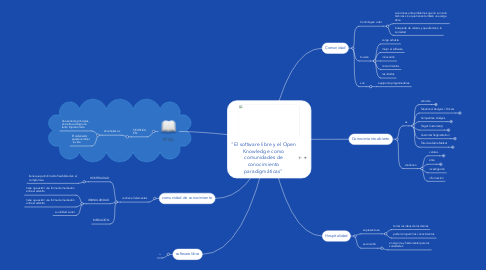
1. ÉTICA
1.1. SE APLICA EN
1.1.1. etica haker es
1.1.1.1. Una serie de principios, en cierta axiología un tanto imprecionista
1.1.1.2. El ordenador puede cambiar la vida
2. comunidad de conocimiento
2.1. contiene 3 elementos
2.1.1. HOSPITALIDAD
2.1.1.1. tiene que permitir cierta flexibilidad en el compromiso
2.1.2. GRANULARIDAD
2.1.2.1. tiene que existir una forma de mediación entre el adentro
2.1.2.2. tiene que existir una forma de mediación entre el adentro
2.1.2.3. su utilidad social
2.1.3. MEDIACIÓN
3. software libre
3.1. +
4. Comunidad
4.1. Contribuyen a dar
4.1.1. soluciones ante problemas que no son solo técnicos sino que tienen también una carga ética
4.1.2. búsqueda de valores y que afectan a la sociedad
4.2. buscan
4.2.1. carga activista
4.2.2. mejor el software
4.2.3. innovación
4.2.4. conocimientos
4.2.5. resultados
4.3. son
4.3.1. equipo de programadores
5. Conocimiento abierto
5.1. es
5.1.1. activista
5.1.1.1. Service Offer
5.1.1.1.1. What are we selling?
5.1.1.1.2. Product Definition
5.1.1.1.3. Pricing
5.1.1.1.4. Packaging
5.1.1.1.5. Positioning
5.1.1.2. Value Proposition
5.1.1.2.1. What is the Value Proposition to the Customer?
5.1.1.2.2. What pain are we solving?
5.1.2. Situational Analysis / Drivers
5.1.2.1. What is driving us to do this?
5.1.2.2. SWOT Analysis
5.1.2.2.1. Strengths
5.1.2.2.2. Weaknesses
5.1.2.2.3. Opportunities
5.1.2.2.4. Threats
5.1.2.3. Customer Findings - What have we learned from customers?
5.1.3. Competitive Analysis
5.1.3.1. Do we have competitors and threats in these target markets with the proposed offerings?
5.1.3.2. What are our competitors doing and how are they positioning?
5.1.3.3. How do we position against each competitor?
5.1.4. Target Customer(s)
5.1.4.1. Buyer Profile
5.1.4.1.1. Title
5.1.4.1.2. Industry
5.1.4.1.3. Geography
5.1.4.1.4. Business Size
5.1.4.2. Influencer Profile
5.1.4.3. User Profile
5.1.4.4. What do customers want and need?
5.1.4.5. What business problems do each of these customers have?
5.1.5. Customer Segmentation
5.1.5.1. Which customers or sets of customers do we sell to?
5.1.5.2. What are the target market segments that we want to go after?
5.1.5.3. What are the distinct problems for each segment of the market?
5.1.6. Total Available Market
5.1.6.1. New Prospects
5.1.6.1.1. How much of each target segment have we penetrated?
5.1.6.1.2. How much opportunity is available in each target segment?
5.1.6.2. Existing Customers
5.1.6.2.1. Can we up-sell existing customers?
5.2. contienen
5.2.1. valores
5.2.1.1. Sales Strategy
5.2.1.1.1. Direct Sales Strategy
5.2.1.1.2. Inside Sales Strategy
5.2.1.1.3. Channel Sales Strategy
5.2.1.2. Partner Strategy
5.2.1.2.1. Channel Strategy
5.2.1.2.2. Technology Partnerships
5.2.1.2.3. Solutions Partners
5.2.2. ética
5.2.2.1. Revenue and P&L Forecast (5 Years)
5.2.2.2. Revenue should be split out quarterly
5.2.3. investigación
5.2.4. información
6. Hospitalidad
6.1. se presenta en
6.1.1. tomar las ideas de los demás
6.1.2. poder compartir los conocimientos
6.2. se convirtió
6.2.1. en algo muy fundamental para las sociedades

